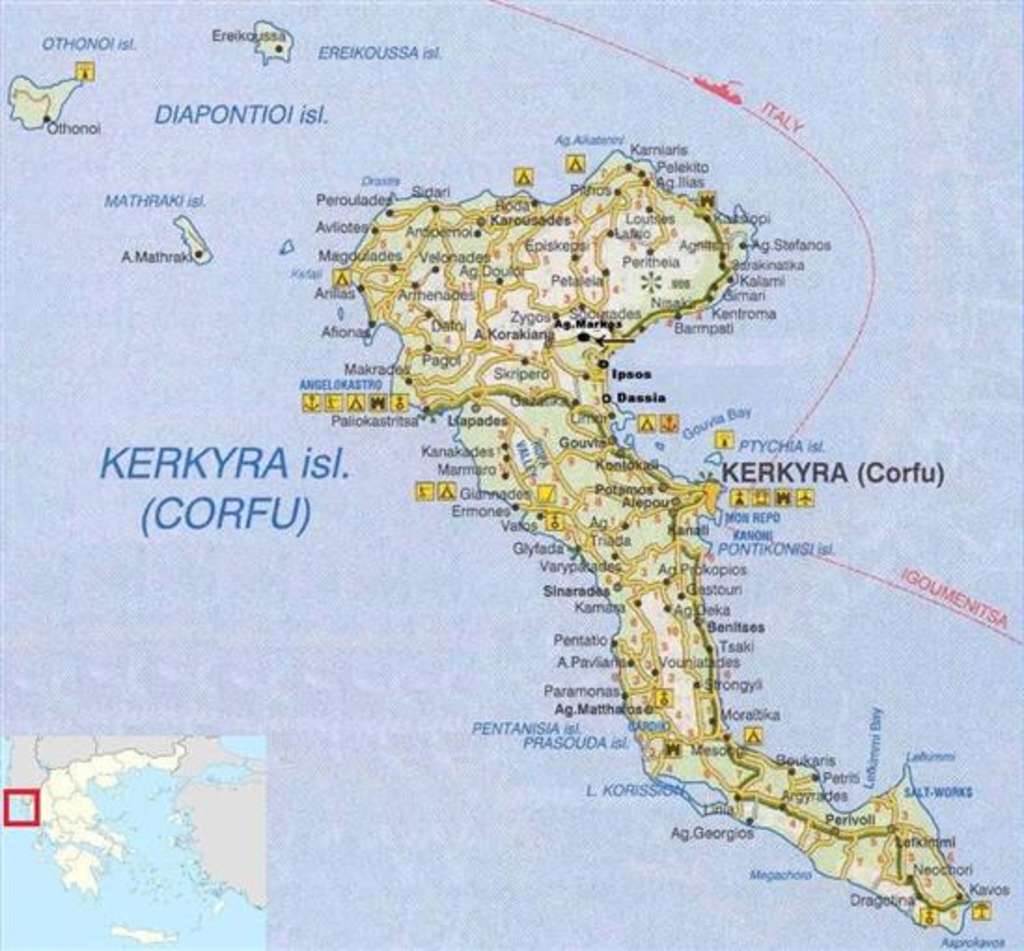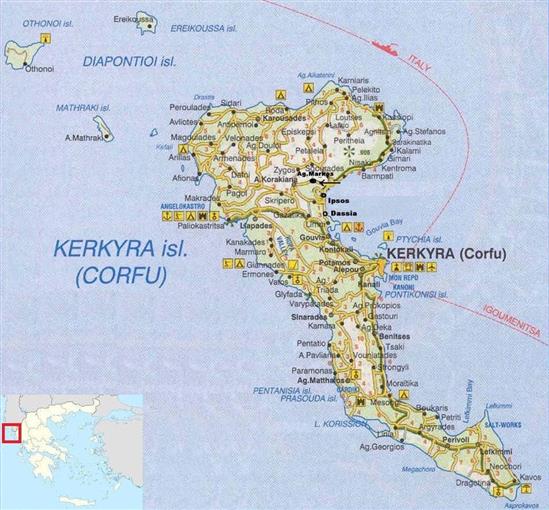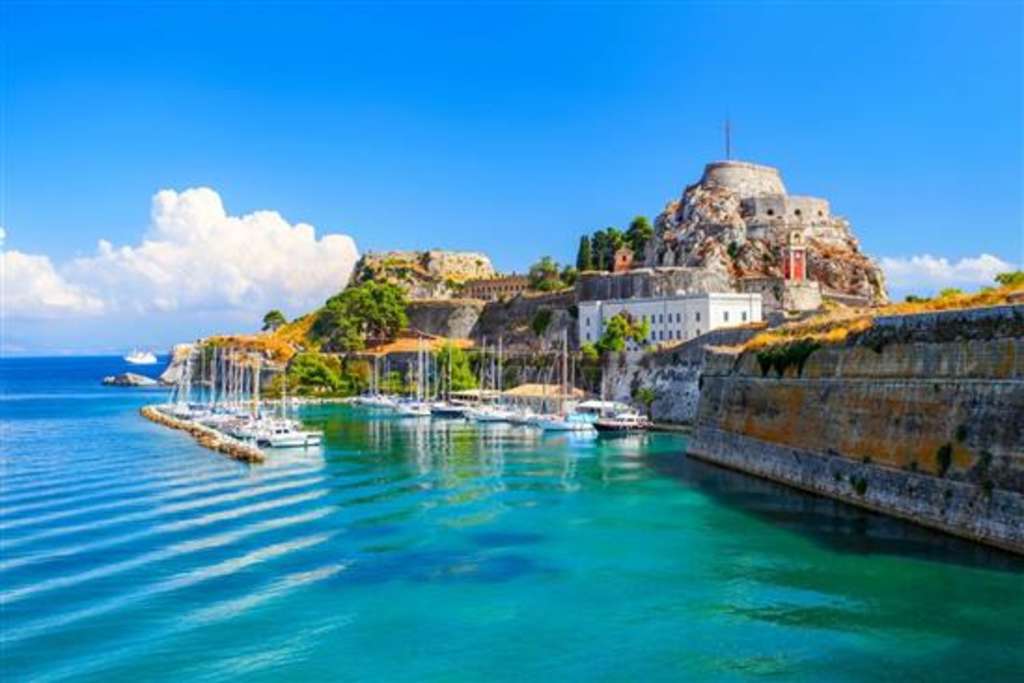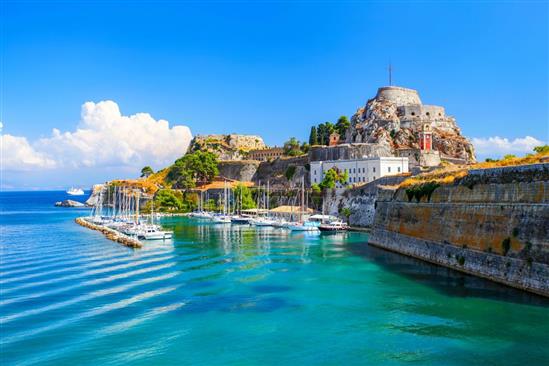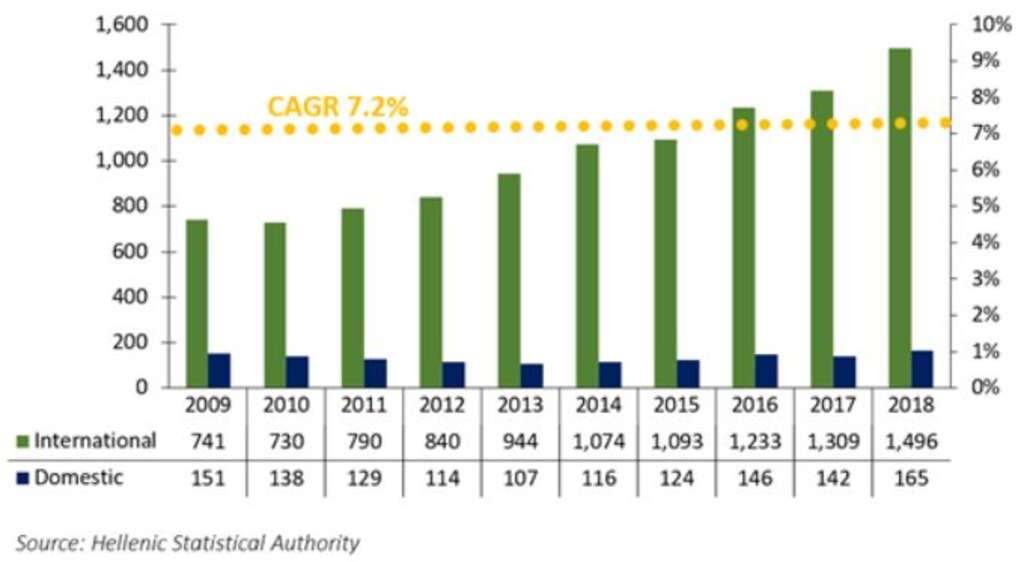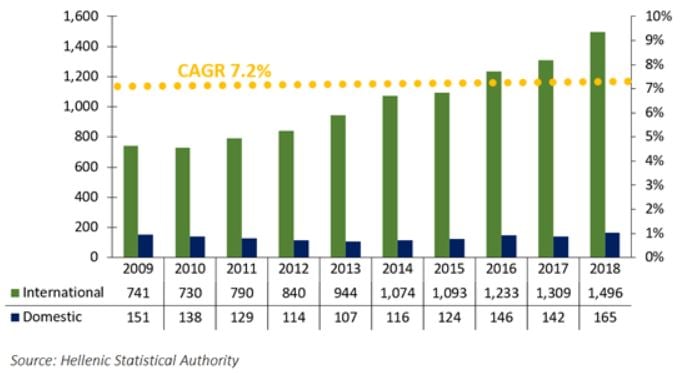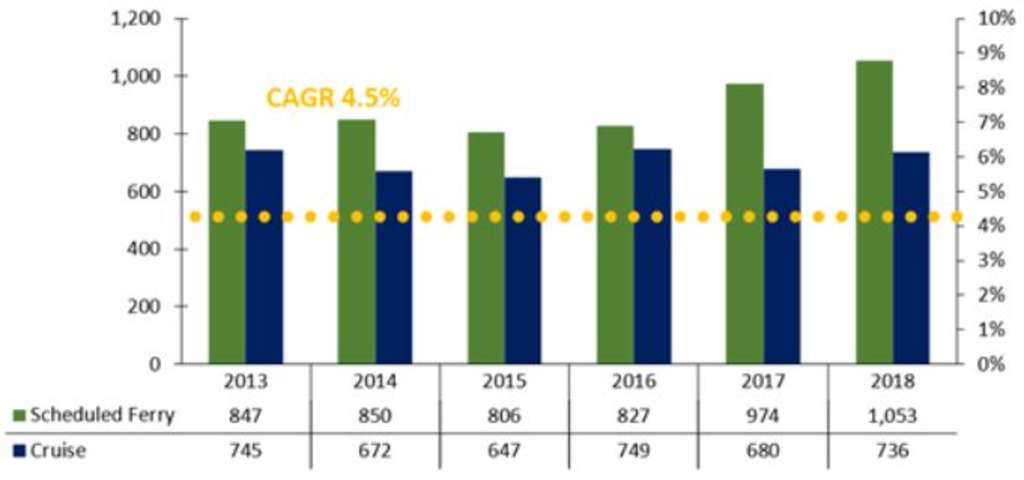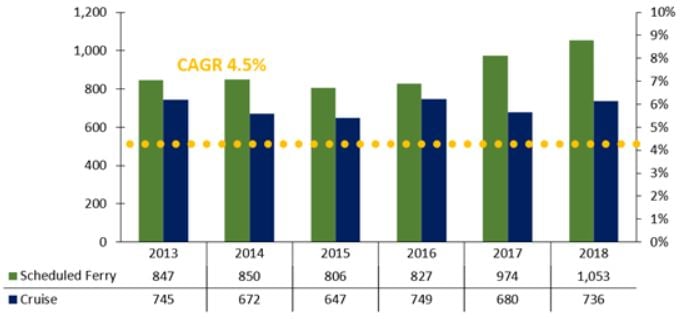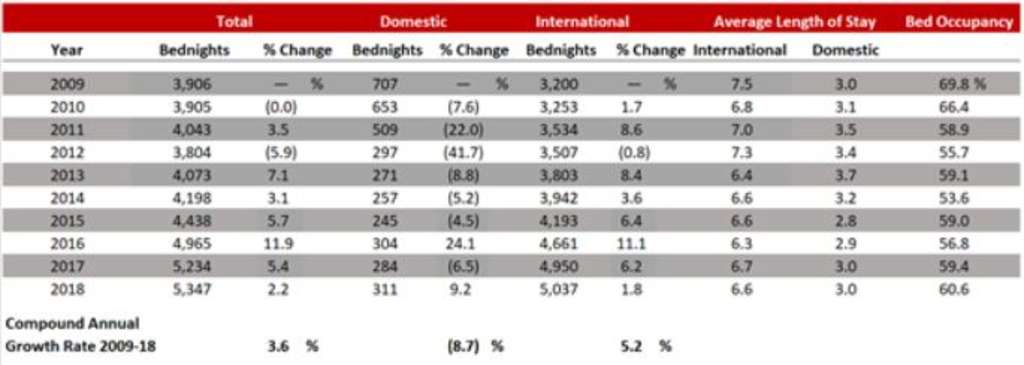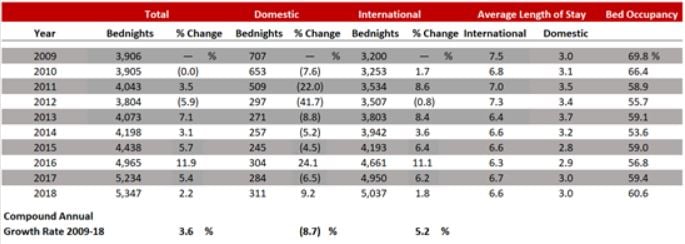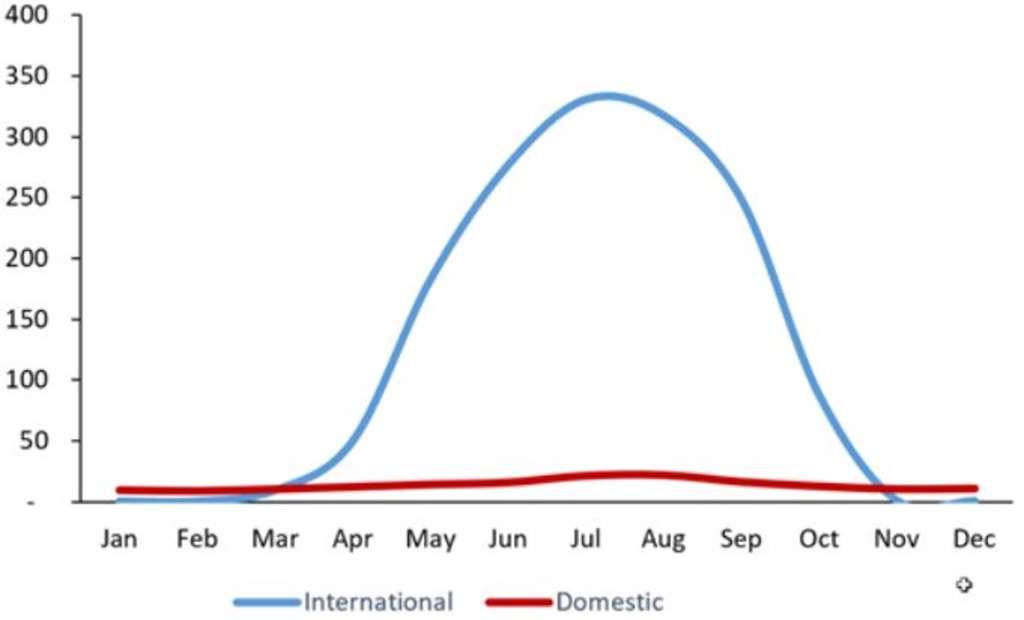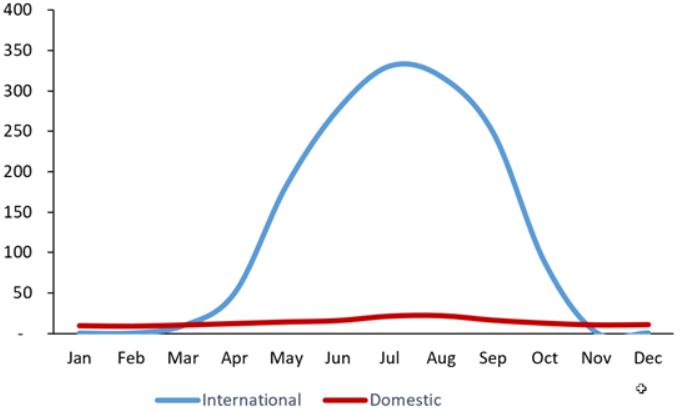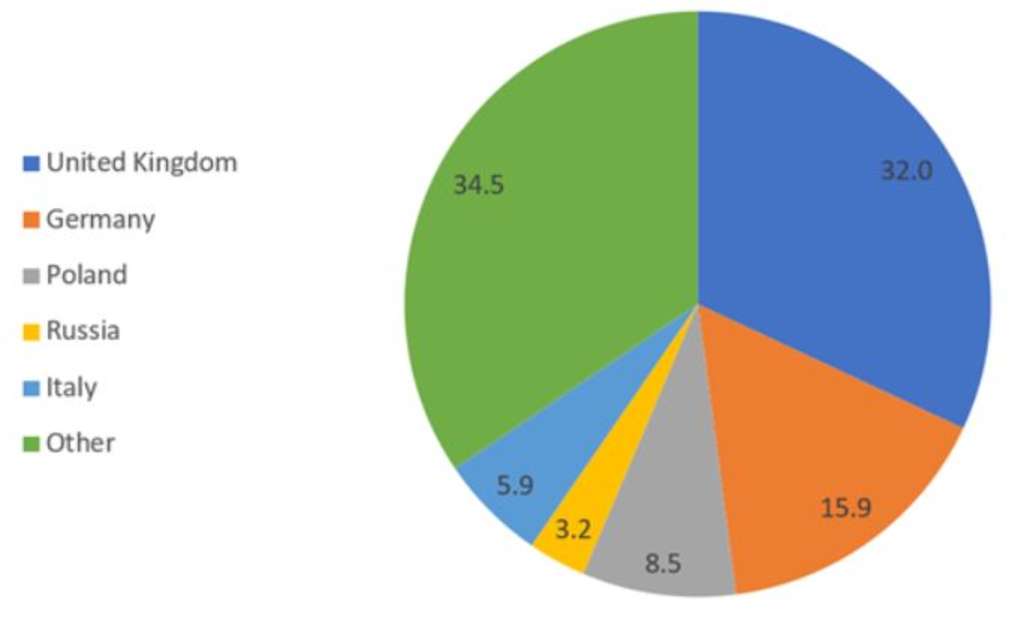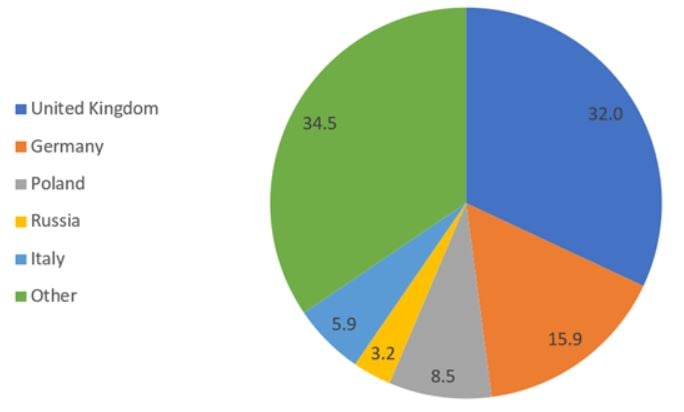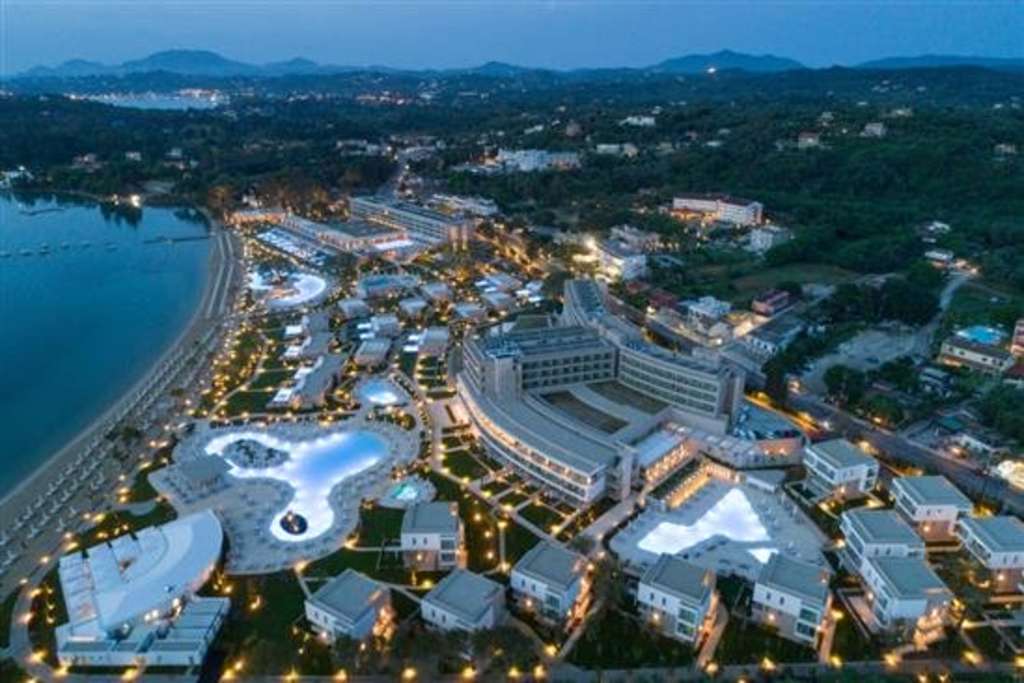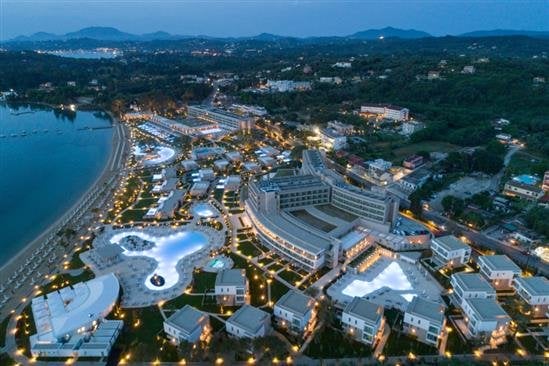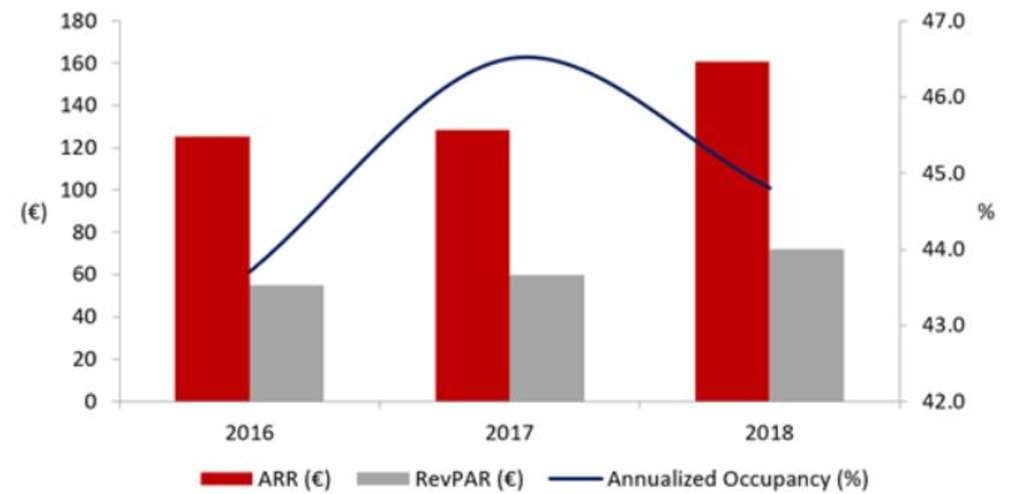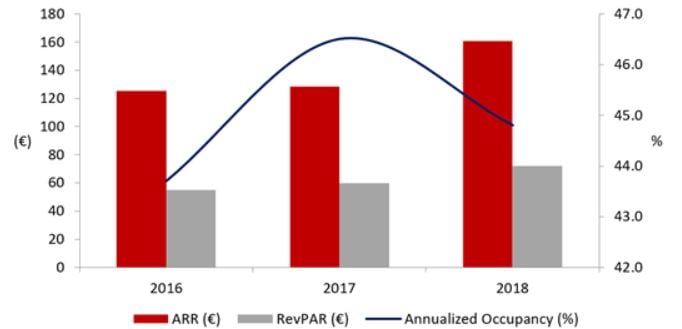In Focus: Corfu, Greece
Introduction
The region of the Ionian Islands consists of the islands in the Ionian Sea on the western coast of Greece. Since they have long been subject to influences from Western Europe, the Ionian Islands form a separate historic and cultural unit than that of continental Greece. The region is divided administratively into four prefectures (Corfu, Lefkada, Kefallinia and Zakinthos) and comprises the islands of Kerkira (Corfu), Zakinthos, Cephalonia (Kefallinia), Lefkada, Ithaca (Ithaki), Paxi, and a number of smaller islands. The Ionian Islands are the sunniest part of Greece, but the southerly winds bring abundant rainfall.
The region is noted for its natural beauty, its long history, and cultural tradition. It is also well placed geographically, since it is close to both mainland Greece and Western Europe and thus forms a convenient stepping-stone, particularly for passenger traffic between Greece and the West. These factors have favored the continuous development of tourism, which has become the most dynamic branch of the region's economy.
Island of Corfu
Corfu is located in the northwest part of Greece, with a size of 593 km2 and a costline, which spans for 217 km, is the largest of the Ionian Islands. The principal city of the island and seat of the municipality is also named Corfu, after the island's name, with a population of 32,000 (2011 census) inhabitants. Currently, according to real estate agents, foreign nationals who permanently reside on Corfu are estimated at 18,000 individuals. The majority of these foreign nationals represent British and Irish citizens. Approximately 65% of Corfu is lowland. By virtue of its geographical position, its international airport and its ferry connections, the island is one of the main western gateways to Greece. The island is one of the most popular destinations for international tourists in Greece. Corfu town attracts tourism all-year-round, whereas the rest of the island targets seasonal tourism, mainly during summer months. The most developed areas regarding tourism infrastructure are: Corfu town, Dassia and Kommeno Bay north of Corfu town (targeting the luxury segment), the coastline from Benitses to Korakades (targeting the mid- to upscale market) and Cavos village (targeting the lower end of the market) in the south.
Corfu's Venetian Port
Major Tourism Attractions
Corfu, unlike the rest of Greece, never fell under the Ottoman rule. Due to the successive dominations of the Venetians, the French and the British over the centuries, the island has primarily become part of the Western world. Their culture wielded strong influence in the city since the first Greek University (the Ionian Academy), the first Philharmonic Orchestra and the First School of Fine Arts were founded on the island while the preserved Old Town of Corfu is characterized as a World Heritage Site by UNESCO due to its Renaissance, Baroque and Classical architectural style.
The city also includes other prominent spots like Spianáda (the largest square in the Balkans is the center of the city whereon musical concerts can be attended throughout the year), Listón (the city's trademark promenade), the 15th century Old Fortress, as well as the New Fortress, the Saint Michael and George Palace (that accommodates the only Museum of Asian Art in Greece), and a considerable number of churches. The most imposing one is the city's Cathedral, the Church of St. Spyridon, the island's patron Saint, whose relics are kept here.
Other sites located around the city of Corfu are also some of the most visited on the island like Mon Repos Palace with colonial elements, which today operates as a museum, Kanoni offering from its circular terrace an amazing view across the island of Pontikoníssi, one of the most photographed spots of Corfu, Paleopolis (at Mon Repos estate) standing where the Agora of the ancient city of Corfu was located, and Achilleion that is a summer palace built in the 1890s for the Empress Elisabeth of Austria, but is currently operating as one of Corfu's most popular museum and tourist attraction. The entire region boasts numerous kilometres of coastline and plenty of beaches, nine of which have been awarded the "Blue Flag" designation. Furthermore, the largest marina in Greece, featuring 1,235 berths and also awarded with the "Blue Flag", is located in the area of Gouvia while a recently restructured 18-hole golf course in located in Ropa Valley.
The climate of Corfu is Mediterranean with mild winters and warm but comfortable summers. The economy of the prefecture has evolved around tourism. The development of tourism-related businesses coincied with the gradual shutdown of the traditional industries of the prefecture and the decrease in the number of small business for the production of traditional products, such as cheese, sausages, gold and silver jewelry, and so forth. A favorite with the British since Victorian times, Corfu offers some of the finest landscapes in the Mediterranean region and it has maintained its popularity among the ultra high net worth indivuals, as members of the Rothchild family and Russian oligarchs are homeowners in the northeast part of the island.
Accessibility
By Air
Corfu International Airport, 'Ioannis Kapodistrias' is located three kilometers from the town of Corfu. It is one of the busiest airports in the broader region of the Ionian Islands providing direct flights to and from all major European cities, as well as most of the major Greek cities. During the tourist season the vast majority of the non-chartered flights to the island are those offered by Olympic Airlines and Aegean Airlines (servicing the island on a year-round basis) as well as the ones operated by low-cost carriers like Easyjet and Ryanair.
Figure 1: International and Domestic Airport Arrivals - Corfu 2009-18 (000s)
In December 2015, the privatization of operations of the Corfu International Airport and 13 other regional Greek airports was finalized with the signing of the agreement between the Fraport AG/Copelouzos Group joint venture and the state privatization fund. Immediate actions that have already been taken after Fraport Greece took over operations. According to press releases, it is expected a new terminal to be built and the current one to be expanded.
Corfu International Airport is one of the busiest airports in the broader region of the Ionian Islands providing direct flights to and from all major European cities, as well as most of the major Greek cities. Total airport arrivals in Corfu grew at a Compound Annual Growth Rate (CAGR) of 7.2% during the past ten years, primarily attributed to the high increase in foreign passenger arrivals. International airport arrivals remained to levels far below 800,000 during 2009-11, while they reached an all-time record of more than 1.66 million in 2018 after a period of constant increase, as a result of the general increase of the tourism sector in Greece. Especially for the period 2010-14, total airport arrivals recorded a CAGR of 10.1% mainly driven by the constant annual increase in international travelers.
By Sea
There are two sea gates in the island, Leukimi in the south and Corfu town in the central part. The main harbor is located in Corfu town and accepts not only scheduled ferry connections with Italian destinations but also ferries connecting the island with domestic harbors like the one in Patra and Igoumenitsa. Moreover, Corfu receives an increasing number of transient cruise ship passengers each summer season. The second harbor of the island, Leukimi, takes advantage of its prime location (proximity to the main land Greece) and provides scheduled ferry connections with Igoumenitsa harbor.
Figure 2: Cruise and Scheduled Ferry Passenger Arrivals - Corfu 2013-18 (000s)
Total arrivals by sea in Corfu ports grew at a healthy CAGR of 4.5% during the past six years primary driven by the sharp increase scheduled ferries passengers, while the cruise passngers decreased by -1.2%. The aforementioned steady level in cruise passengers is believed to have taken place due to the political instability of the primary feeder markets (United Kingdom and Germany). Adding to this factor, the reduction of the cruise ships size compared with the past and other operational issues that migh occur that could cancel the scheduled timetables. However, a considerable increase of 6.5% was expected for 2019 tourist season and preliminary results confirm that trend.
Demand for Transient Accommodation
Basic Visitation Factors
Visitation at hotels in the city of Corfu has been mainly of international nature; foreign visitation, in terms of accommodated bednights, accounted for almost 95% over the most recent years and over 90% since 2012, while domestic tourists staying in the island are mainly Greeks travelling for corporate/business purposes to Corfu city or a limited number of local travellers on leisure trips.
Domestic tourists have been reduced to half from the era of greek economical crisis and they have not be able to recover since then. On the over hand, international tourists arrivals, which achieved over five million bednights for first time ever in 2018, have experienced a considerable average annual growth of 5.2%.
Figure 3: Accommodated Bednights in Corfu 2009-18 (000s)
The projection for the 2019 tourism season involved a slight decrease in the international arrivals, as the island experienced a constant growth over the past years. On 23 September 2019, the tourism industry of Corfu was severely affected by the collapse of Thomas Cook, the oldest tour operator in the world. Thomas Cook was responsible for three million tourist arrivals in Greece on annual basis. According to a recent study conducted by the Greek Chamber of Hotels, 27% of all hotels in the Ionian islands were affected by this event. Specifically, in Corfu the total lost hotel revenue is estimated at approximately €35 million for 2019, while it is estimated to reach €108 million in 2020. Major other tour operators, which are the key players in Corfu's tourism market, are acting towards recovering the gap left behind by the collapse of Thomas Cook. However, it is considered as an extremely challenging task and there is a plethora of difficulties that need to be overcome. Hence, it is essential, not only for Corfu, but for the entire country as well, to restructure its marketing strategy and destination management policy in an effort to counter the enormous impact of the collapse of Thomas Cook on the hospitality sector and maintain the strong correlation between Greece's tourism industry and its national economy.
Seasonality
As in the majority of leisure tourism destinations in Greece, the highest arrival figures in Corfu occur during June - August with the airport recording almost two million arrivals and hotels reaching or sometimes exceeding 95% of occupancy.
The tourism industry on the island is mostly seasonal, with the majority of hotels operating seven months from late March to late October. In more details, the seasonality follows a typical trend for summer resort destinations where the distinct bell-shaped curve peaks in mid-July/August, the traditionally busiest summer vacation period in Greece. Various efforts have been made towards the extension of the seasonality of the destination's visitation. The recent concession of the airport together with the stabilisation of cruise ship approaches are both factors that could play a major role in extending the operating season of the hotels and other tourism businesses in Corfu, ideally on a year-round basis in the longer term. During the winter months, there are only two major hotels operating on the island, offering a total of about 370 rooms and accommodating the needs of visitors who travel to the island for business or leisure purposes. Within the city of Corfu there are also plenty other hotels that remain open of lower classification though.
Figure 4: Monthly Airport Passenger Movements - Corfu 2018 (000s)
Source Markets
Based on the recorded airport arrivals, United Kingdom and Germany is by far the dominant markets for visitation, with Poland being the only other country with notable presence. Corfu establishment as a leisure destination in the culture of the Great Britain and Germany is dated back to 1950s, the familiarity with the region and the awareness developed with the word-of-mouth over the years.
Figure 5: Top 5 International Feeder Markets
Hotel Supply
The majority of hotels are classified as one- and two-star, while the absence of five-star units is quite evident, being at only 5.8% of the total hotel supply in 2018. Nevertheless, five- and four-star hotel units together represent almost half of the island's rooms and beds supply, 47% and 48% respectively. It must be noted that although 22 hotels are officially classified as five‐star, 30% more than 2017, the physical conditions and facilities of the majority of these units do not correspond to international luxurious standards. Only a limited number of these hotels could be considered as 'five‐star' hotels in terms of physical product and services offered. The majority of the hotels on the island underwent major refurbishment prior to 1994 in preparation for hosting the 1994 European Summit and most of them did not invest more capital ever since. This situation changed over the period 2016-18 during which the island experienced some major changes in the upper spectrum of the market after many years of stagnation.
In 2018, the average five-star hotel in Corfu featured 209 rooms and 426 beds, a size increased compared with the average size in 2014. In general, the average hotel size is only 60 rooms since the region is dominated by small family-run hotels. Hotel supply in other categories remained almost unchanged for the entire examined period.
Figure 6: Hotel Supply in Corfu Island 2010-18
Recent and Forthcoming Tourism Developments
Some of the most notable recent tourism developments in the island of Corfu are the following:
- Two historic hotels of the island, namely Corfu Chandris and Dassia Chandris, were purchased in November 2016 by Ikos Hotels to be fully renovated and they were relaunched in the market in May 2018 as a single five-star unit named Ikos Dassia with 403 rooms, suites and bungalows.
Ikos Dassia
- In August 2018, Ledra Hotels and Villas S.A. announced that it had rented Corfu's Miramare Hotel, acquired in 2004 by Pimara SA, Qatar's Al Rayyan investment entity for €15 million. After an estimated €35 million worth of renovation works, the 113-room hotel is currently under the Domes Resorts brand as the five-star, adults-only Domes Miramare affiliated with The Luxury Collection brand by Marriott International.
With regards to new developments coming into the market, the two most noteworthy are:
- Angsana Corfu, a five star property of the Banyan Tree Group, is estimated to launch in Spring 2020 featuring 199 rooms, following several years of planning and development of the former San Stefano hotel near the village of Benitses.
- In January 2013 the board of directors of the Hellenic Republic Asset Development Fund (HRADF) approved the binding financial offer by NCH Capital for the acquisition of 100% of the stake of the Special Purpose Vehicle, to which the HRADF will transfer the concession rights of the property development for a period of 99 years for a beach front plot of land at Kasiopi, Corfu. This is an investment of approximately €100 million, including €23 million for the acquisition of the leasehold, €2.3 million of an earn-out clause and an estimated amount of €75 million for the development of the property. The total area of the property is 490,000 m², on which the investor will have the right to develop a gross buildable area of about 36,000 m² including a 90-key hotel on top of approximately 70 apartments and 50 villas for outright sale. The project, although officially presented to the public in late 2016, is currently on hold from the investors due to various bureaucratic issues that are expected to be overcome within 2019 and construction to begin shortly.
Lastly, Corfu Gardens S.A., a Russian-backed hotel real estate development company, plans to develop an ultra-upscale 180-room hotel under the Fairmont flag on the site of the former Club Mediterranee, which operated under the Club Med name until 2003. The site of the proposed Fairmont Corfu Resort and Spa is located in the area of Ipsos, about ten kilometres north of the town of Corfu, on a peninsula that overlooks the sea and measures about 265,000 m². The proposed hotel is planned to be constructed and positioned in the market featuring new rooms, food and beverage outlets, a spa and wellness centre, and conference facilities. The site is assumed to be further developed with a residential component featuring 40 Fairmont-branded villas and 45 apartments. However, although plans were officially presented back in 2008, the project is currently on hold from the investors.
Hotel Performance
The following table provides an indication of the evolution of performance of 17 upscale hotel properties on the island Corfu (including Corfu city and resort areas) over the last three years based on actual data. It should also be noted that all occupancy percentages refer to 365 days of operation for consistency reasons.
Figure 7: Operating Performance - Corfu Upscale Hotels 2016-18
During the period 2016-18, the average rate of examined hotels improved from approximately €125 to overpass the €160 with the highest figures, north of €200, being recorded at the hotels located in Kommeno Bay and Dassia. The rationale of its prime positioning comes mainly for historical reasons and the constant focusing of the resorts to high-spending power individual, who prefer to book directly their accommodation. On the hand, Sidari and the coastline from Benitses to Korakades are mainly targeting pachage holidays, through Tour Operators.
During the same period figures depicting occupancy rate recorded a fluctuation, ranging between 43.5% and 46.5% (when annualised). Resort hotels in the island usually operate between 175 and 185 days annually, which is on the average of the country. In other words, hotels in Corfu operate with more than 90% seasonal occupancy. The area is a purely leisure destination with only some limited corporate activity that consists mainly of domestic business travelers throughout the year. On top of that, during spring months and especially at Orthodox Easter, domestic travllers generate high demand for room accomodation, mainly in the Old Town, hence the prices are skyrocketed.
© HVS October 2019
